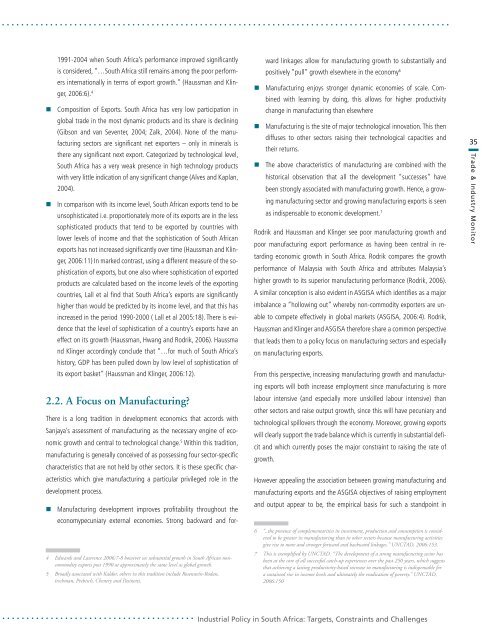Monitor Vol 39 08_Final_Nov08.pdf - tips
Monitor Vol 39 08_Final_Nov08.pdf - tips
Monitor Vol 39 08_Final_Nov08.pdf - tips
Create successful ePaper yourself
Turn your PDF publications into a flip-book with our unique Google optimized e-Paper software.
1991-2004 when South Africa’s performance improved significantly<br />
is considered, “…South Africa still remains among the poor performers<br />
internationally in terms of export growth.” (Haussman and Klinger,<br />
2006:6). 4<br />
• Composition of Exports. South Africa has very low participation in<br />
global trade in the most dynamic products and its share is declining<br />
(Gibson and van Seventer, 2004; Zalk, 2004). None of the manufacturing<br />
sectors are significant net exporters – only in minerals is<br />
there any significant next export. Categorized by technological level,<br />
South Africa has a very weak presence in high technology products<br />
with very little indication of any significant change (Alves and Kaplan,<br />
2004).<br />
• In comparison with its income level, South African exports tend to be<br />
unsophisticated i.e. proportionately more of its exports are in the less<br />
sophisticated products that tend to be exported by countries with<br />
lower levels of income and that the sophistication of South African<br />
exports has not increased significantly over time (Haussman and Klinger,<br />
2006:11) In marked contrast, using a different measure of the sophistication<br />
of exports, but one also where sophistication of exported<br />
products are calculated based on the income levels of the exporting<br />
countries, Lall et al find that South Africa’s exports are significantly<br />
higher than would be predicted by its income level, and that this has<br />
increased in the period 1990-2000 ( Lall et al 2005:18). There is evidence<br />
that the level of sophistication of a country’s exports have an<br />
effect on its growth (Haussman, Hwang and Rodrik, 2006). Haussma<br />
nd Klinger accordingly conclude that “…for much of South Africa’s<br />
history, GDP has been pulled down by low level of sophistication of<br />
its export basket” (Haussman and Klinger, 2006:12).<br />
2.2. A Focus on Manufacturing?<br />
There is a long tradition in development economics that accords with<br />
Sanjaya’s assessment of manufacturing as the necessary engine of economic<br />
growth and central to technological change. 5 Within this tradition,<br />
manufacturing is generally conceived of as possessing four sector-specific<br />
characteristics that are not held by other sectors. It is these specific characteristics<br />
which give manufacturing a particular privileged role in the<br />
development process.<br />
• Manufacturing development improves profitability throughout the<br />
economypecuniary external economies. Strong backward and for-<br />
4 Edwards and Lawrence 2006:7-8 however see substantial growth in South African noncommodity<br />
exports post 1990 at approximately the same level as global growth.<br />
5 Broadly associated with Kaldor, others in this tradition include Rosenstein-Rodan,<br />
irschman, Prebisch, Chenery and Pasinetti.<br />
ward linkages allow for manufacturing growth to substantially and<br />
positively “pull” growth elsewhere in the economy 6<br />
• Manufacturing enjoys stronger dynamic economies of scale. Combined<br />
with learning by doing, this allows for higher productivity<br />
change in manufacturing than elsewhere<br />
• Manufacturing is the site of major technological innovation. This then<br />
diffuses to other sectors raising their technological capacities and<br />
their returns.<br />
• The above characteristics of manufacturing are combined with the<br />
historical observation that all the development “successes” have<br />
been strongly associated with manufacturing growth. Hence, a growing<br />
manufacturing sector and growing manufacturing exports is seen<br />
as indispensable to economic development. 7<br />
Rodrik and Haussman and Klinger see poor manufacturing growth and<br />
poor manufacturing export performance as having been central in retarding<br />
economic growth in South Africa. Rodrik compares the growth<br />
performance of Malaysia with South Africa and attributes Malaysia’s<br />
higher growth to its superior manufacturing performance (Rodrik, 2006).<br />
A similar conception is also evident in ASGISA which identifies as a major<br />
imbalance a “hollowing out” whereby non-commodity exporters are unable<br />
to compete effectively in global markets (ASGISA, 2006:4). Rodrik,<br />
Haussman and Klinger and ASGISA therefore share a common perspective<br />
that leads them to a policy focus on manufacturing sectors and especially<br />
on manufacturing exports.<br />
From this perspective, increasing manufacturing growth and manufacturing<br />
exports will both increase employment since manufacturing is more<br />
labour intensive (and especially more unskilled labour intensive) than<br />
other sectors and raise output growth, since this will have pecuniary and<br />
technological spillovers through the economy. Moreover, growing exports<br />
will clearly support the trade balance which is currently in substantial deficit<br />
and which currently poses the major constraint to raising the rate of<br />
growth.<br />
However appealing the association between growing manufacturing and<br />
manufacturing exports and the ASGISA objectives of raising employment<br />
and output appear to be, the empirical basis for such a standpoint in<br />
6 “..the presence of complementarities in investment, production and consumption is considered<br />
to be greater in manufacturing than in other sectors because manufacturing activities<br />
give rise to more and stronger forward and backward linkages.” UNCTAD, 2006:153.<br />
7 This is exemplified by UNCTAD. “The development of a strong manufacturing sector has<br />
been at the core of all successful catch-up experiences over the past 250 years, which suggests<br />
that achieving a lasting productivity-based increase in manufacturing is indispensable for<br />
a sustained rise in income levels and ultimately the eradication of poverty.” UNCTAD,<br />
2006:150<br />
35<br />
Trade & Industry <strong>Monitor</strong><br />
Industrial Policy in South Africa: Targets, Constraints and Challenges
















